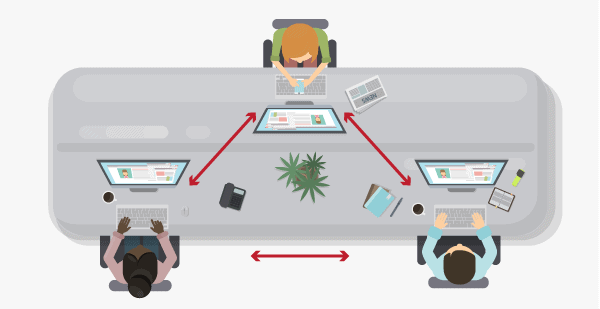Returning to work can be a stressful time for both managers and employees. Organisations have to reorganise their workplaces and work processes to help prevent the spread of Covid-19. Then, employers need to find solutions for how to effectively implement and monitor these new control measures, which are not easy tasks for any organisation in any industry.
However, while your organisation might have tackled all of the requirements to keep people safe and healthy, your efforts will only go so far without getting your staff to commit to these new safety measures.
So how can you create a culture that will engage employees and get their buy-in to this new ‘normal’?
While there are many challenges ahead, we’ve compiled some tips for what type of control measures you might need to implement and how you can get employees on board so that everyone’s health, safety and welfare is protected as people return to work.
Risk assessment and control measures
The first step in taking care of employee health, safety and wellbeing is carrying out a risk assessment. This will help you:
- Examine the workplace and work activities that might cause transmission of the virus
- Identify who might be harmed, such as people with underlying health conditions
- Assess the level of risk
- Determine what control measures need to be implemented to mitigate those risks
Control measures might include:
- Creating a response plan in case an employee develops symptoms or suspects they might have Covid-19 while at work
- Changing the workplace layout to allow for social distancing according to government guidelines, for example, workstations, canteens, meeting rooms, walkways
- Staggering employee start times and lunch schedules or creating a rota to reduce the number of people in the workplace at once
- Reducing the number of shared spaces and equipment, for example, instating a take away only canteen
- Implementing regular and effective cleaning and disinfecting routines by staff and cleaning personnel
- Providing more handwashing facilities and materials so people can frequently and properly wash their hands, and provide hand sanitisers where handwashing facilities are not available
- Encouraging employees to maintain good personal hygiene and implementing good cleaning practices through regular reminders and sign postage
- Providing personal protective equipment (PPE) if it is considered appropriate for the present risks and conditions

What is most appropriate for your workplace will depend on many factors, such as the industry you work in, how many people are returning to work, and the nature of each person’s job.
Involve your employees
While it is critical to assess the risks and put controls in place to protect everyone’s health and safety, it won’t be successful without employees doing their part. For example, you could have made handwashing facilities, hand sanitisers and cleaning supplies readily available throughout the workplace, but if no one uses them, these measures become redundant.
One of the best ways to create engagement and get your employees to commit to health and safety changes is to get them involved. Ask them to help you identify the hazards and assess the risks. It can be as easy as talking and listening to your staff about what they think should be implemented to help them work safely. Another more streamlined process would be to do this through a people risk assessment software.
You can enrol all of your staff on the risk assessment helping you to easily identify, assess and manage most if not all of the risks in the workplace. Getting your staff involved in this process not only protects them, but it can also create a culture of trust and partnership between employers and employees. It can also reassure staff that you and the organisation view their health and safety as a priority.
Transparency is another important element in gaining commitment. Share your findings of the risk assessment with your entire workforce so they understand:
- That you are complying with the government’s guidance to manage the risk of transmission of Covid-19
- You are doing everything possible to keep them safe and healthy at work
- What they are required to do to comply with the risk assessment and any new procedures in place
Communicate regularly about work processes and changes
Regular communication about workplace changes is another key component of engagement and compliance. Update employees on all new processes and procedures and send out communications regarding any process changes. For example, keep them informed about:
- When they should arrive at work, take breaks and leave work
- How often they should wash their hands, use hand sanitiser or clean their workstations
- What to do if they develop symptoms of Covid-19 while at work
Sending out communications doesn’t have to be a burden – software can help automate communications and track acceptance for compliance. Online training is another great way to get your organisation’s messages across to your entire organisation in a fast, concise way. An authoring tool can make it simple to customise training and communication to ensure it is relevant and specific to your organisation’s procedures for returning to work.
Providing feedback
Just like in the risk assessment process, encourage employees to continuously look for hazards and areas of improvement to help keep everyone safe. Check with them to see how things are going and that you value their feedback.
If things are working well, communication shouldn’t stop there. If people are complying with the control measures in place and are taking responsibility for the health and safety of everyone in the workplace, take time to communicate that to your staff. Recognise and praise their effort and commitment towards preventing the spread of Covid-19 and keeping a safe and healthy work environment. Appreciating their commitment can go a long way during these challenging times.
Recognise different needs and take care of everyone’s wellbeing
Every employee has different circumstances that could create vulnerabilities or challenges when returning to work. For example, workers might:
- Have underlying health conditions that make them more vulnerable
- Need to take care of family or have personal matters that need tending to while they are working
- Be stressed, nervous or anxious about the risks involved in returning to work
- Have difficulties adapting to a new workspace or work schedule
- Feel lonely or isolated
If not cared for properly, these circumstances can lead to more issues, such as increased stress, depression and lower productivity.

Talk to your employees about how the pandemic has affected them personally and professionally. Can you work together to come up with some solutions to help manage those issues? For example, if an employee has child care needs, can their schedule be adapted to help meet their needs? If an employee has an underlying health condition that makes them more vulnerable, can additional measures be implemented, or can they switch to a similar role that would allow them to work safely? What about employees that feel more stressed or anxious about returning to work?
Think about what you can do to help ease their concerns, for example:
- Have conversations with them about specific concerns
- Listen to their concerns and reassure them about the measures in place to protect them
- If they don’t want to speak with a manager, encourage them to talk with a trusted colleague, friend, family member or a medical health professional
- Provide resources to help them take care of their mental health
Conclusion
Gaining employee commitment during these challenging times can be as simple as keeping open lines of communication and encouraging staff to get involved. Praise and recognise staff for their efforts, and take the time to understand and accommodate personal needs. Employees who are involved and feel appreciated and valued are much more likely to get on board with changes in the workplace and, ultimately, feel happier in their role.
The process of returning to work will have many challenges ahead, but by each person doing their part, we can all create and maintain safe and healthy workplaces for everyone returning to work.












